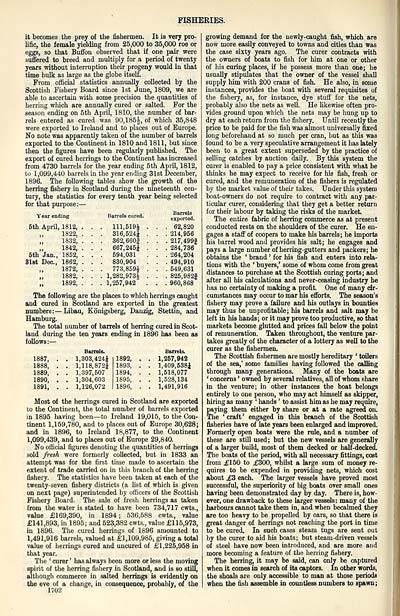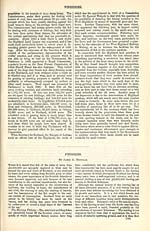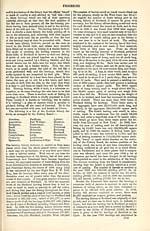Ordnance gazetteer of Scotland
(1710) Page 1702
Download files
Complete book:
Individual page:
Thumbnail gallery: Grid view | List view

FISHEKIES.
it becomes the prey of the fishermen. It is very pro-
lific, the female yielding from 25,000 to 35,000 roe or
eggs, so that Buffon observed that if one pair were
suffered to breed and multiply for a period of twenty
years without interruption their progeny would in that
time bulk as large as the globe itself.
From official statistics annually collected by the
Scottish Fishery Board since 1st June, 1809, we are
able to ascertain with some precision the quantities of
herring which are annually cured or salted. For the
season ending on 5th April, 1810, the number of bar-
rels entered as cured was 90,185^, of which 35,848
were exported to Ireland and to places out of Europe.
No note was apparently taken of the number of barrels
exported to the Continent in 1810 and 1811, but since
then the figures have been regularly published. The
export of cured herrings to the Continent has increased
from 4730 barrels for the year ending 5th April, 1812,
to 1,099,440 barrels in the year endiug 31st December,
1896. The following tables show the growth of the
herring fishery in Scotland during the nineteenth cen-
tury, the statistics for every tenth year being selected
for that purpose: —
Barrels
exported.
. 62,820
. 214,956
. 217,499f
. 284,736
. 264,204
. 494,910
. 549,631
. 825,982|
. 960,868
The following are the places to which herrings caught
and cured in Scotland are exported in the greatest
numbers: — Libau, KSnigsberg, Danzig, Stettin, and
Hamburg.
The total number of barrels of herring cured in Scot-
land during the ten years ending in 1896 has been as
follows: —
Year ending
Barrels cured.
5th April, 1812, . .
111,519£
1822, . .
316,524|
1832, . .
362,660J
1842, . .
667.245J
5th Jan., 1852, . .
594,031
81st Dec, 1862, . .
830,904
1872, . .
773, 859 J
„ 1882, . .
1,282,973*
„ 1892, . .
1,257,942
Barrels.
Barrels.
1887, .
1,303, 424J
1892, .
. 1,257,942
1888, .
1,118,8724
1893, .
. 1,409,538*
1889, .
1.397,507
1894, .
. 1,518,077
1890, .
1,304,603
1895, .
. 1,528,134
1891, .
1,126,072
1896, .
. 1,491,916
Most of the herrings cured in Scotland are exported
to the Continent, the total number of barrels exported
in 1895 having been — to Ireland 19,015, to the Con-
tinent 1,159,780, and to places out of Europe 30,628;
and in 1896, to Ireland 18,877, to the Continent
1,099,439, and to places out of Europe 29,840.
No official figures denoting the quantities of herrings
sold fresh were formerly collected, but in 1833 an
attempt was for the first time made to ascertain the
extent of trade carried on in this branch of the herring
fishery. The statistics have been taken at each of the
twenty-seven fishery districts (a list of which is given
on next page) superintended by officers of the Scottish
Fishery Board. The sale of fresh herrings as taken
from the water is stated to have been 734,717 cwts.,
value £169,390, in 1894 ; 536,588 cwts., value
£141,893, in 1895; and 523,382 cwts., value £116,973,
in 1896. The cured herrings of 1896 amounted to
1,491,916 barrels, valued at £1,109,985, giving a total
value of herrings cured and uncured of £1,225,958 in
that year.
The ' curer ' has always been more or less the moving
spirit of the herring fishery in Scotland, and is so still,
although commerce in salted herrings is evidently on
the eve of a change, in consequence, probably, of the
1702
growing demand for the newly-caught fish, which are
now more easily conveyed to towns and cities than was
the case sixty years ago. The curer contracts with
the owners of boats to fish for him at one or other
of his curing places, if he possess more than one; he
usually stipulates that the owner of the vessel shall
supply him with 200 crans of fish. He also, in some
instances, provides the boat with several requisites of
the fishery, as, for instance, dye stuff for the nets,
probably also the nets as well. He likewise often pro-
vides ground upon which the nets may be hung up to
dry at each return from the fishery. Until recently the
price to be paid for the fish was almost universally fixed
long beforehand at so much per cran, but as this was
found to be a very speculative arrangement it has lately
been to a great extent superseded by the practice of
selling catches by auction daily. By this system the
curer is enabled to pay a price consistent with what he
thinks he may expect to receive for his fish, fresh or
cured, and the remuneration of the fishers is regulated
by the market value of their takes. Under this system
boat-owners do not require to contract with any par-
ticular curer, considering that they get a better return
for their labour by taking the risks of the market.
The entire fabric of herring commerce as at present
conducted rests on the shoulders of the curer. He en-
gages a staff of coopers to make his barrels; he imports
his barrel wood and provides his salt; he engages and
pays a large number of herring-gutters and packers; he
obtains the ' brand ' for his fish and enters into rela-
tions with the ' buyers,' some of whom come from great
distances to purchase at the Scottish curing ports; and
after all his calculations and never-ceasing industry he
has no certainty of making a profit. One of many cir-
cumstances may occur to mar his efforts. The season's
fishery may prove a failure and his outlays in bounties
may thus be unprofitable; his barrels and salt may be
left in his hands; or it may prove too productive, so that
markets become glutted and prices fall below the point
of remuneration. Taken throughout, the venture par-
takes greatly of the character of a lottery as well to the
curer as the fishermen.
The Scottish fishermen are mostly hereditary ' toilers
of the sea,' some families having followed the calling
through many generations. Many of the boats are
' concerns ' owned by several relatives, all of whom share
in the venture; in other instances the boat belongs
entirely to one person, who may act himself as skipper,
hiring as many ' hands ' to assist him as he may require,
paying them either by share or at a rate agreed on.
The ' craft ' engaged in this branch of the Scottish
fisheries have of late years been enlarged and improved.
Formerly open boats were the rule, and a number of
these are still used; but the new vessels are generally
of a larger build, most of them decked or half-decked.
The boats of the period, with all necessary fittings, cost
from ,£150 to £300, whilst a large sum of money re-
quires to be expended in providing nets, which cost
about £Z each. The larger vessels have proved most
successful, the superiority of big boats over small ones
having been demonstrated day by day. There is, how-
ever, one drawback to these larger vessels: many of the
harbours cannot take them in, and when becalmed they
are too heavy to be propelled by oars, so that there is
great danger of herrings not reaching the port in time
to be cured. In such cases steam tugs are sent out
by the curer to aid his boats; but steam-driven vessels
of steel have now been introduced, and are more and
more becoming a feature of the herring fishery.
The herring, it may be said, can only be captured
when it comes in search of its captors. In other words,
the shoals are only accessible to man at those periods
when the fish assemble in countless numbers to spawn;
it becomes the prey of the fishermen. It is very pro-
lific, the female yielding from 25,000 to 35,000 roe or
eggs, so that Buffon observed that if one pair were
suffered to breed and multiply for a period of twenty
years without interruption their progeny would in that
time bulk as large as the globe itself.
From official statistics annually collected by the
Scottish Fishery Board since 1st June, 1809, we are
able to ascertain with some precision the quantities of
herring which are annually cured or salted. For the
season ending on 5th April, 1810, the number of bar-
rels entered as cured was 90,185^, of which 35,848
were exported to Ireland and to places out of Europe.
No note was apparently taken of the number of barrels
exported to the Continent in 1810 and 1811, but since
then the figures have been regularly published. The
export of cured herrings to the Continent has increased
from 4730 barrels for the year ending 5th April, 1812,
to 1,099,440 barrels in the year endiug 31st December,
1896. The following tables show the growth of the
herring fishery in Scotland during the nineteenth cen-
tury, the statistics for every tenth year being selected
for that purpose: —
Barrels
exported.
. 62,820
. 214,956
. 217,499f
. 284,736
. 264,204
. 494,910
. 549,631
. 825,982|
. 960,868
The following are the places to which herrings caught
and cured in Scotland are exported in the greatest
numbers: — Libau, KSnigsberg, Danzig, Stettin, and
Hamburg.
The total number of barrels of herring cured in Scot-
land during the ten years ending in 1896 has been as
follows: —
Year ending
Barrels cured.
5th April, 1812, . .
111,519£
1822, . .
316,524|
1832, . .
362,660J
1842, . .
667.245J
5th Jan., 1852, . .
594,031
81st Dec, 1862, . .
830,904
1872, . .
773, 859 J
„ 1882, . .
1,282,973*
„ 1892, . .
1,257,942
Barrels.
Barrels.
1887, .
1,303, 424J
1892, .
. 1,257,942
1888, .
1,118,8724
1893, .
. 1,409,538*
1889, .
1.397,507
1894, .
. 1,518,077
1890, .
1,304,603
1895, .
. 1,528,134
1891, .
1,126,072
1896, .
. 1,491,916
Most of the herrings cured in Scotland are exported
to the Continent, the total number of barrels exported
in 1895 having been — to Ireland 19,015, to the Con-
tinent 1,159,780, and to places out of Europe 30,628;
and in 1896, to Ireland 18,877, to the Continent
1,099,439, and to places out of Europe 29,840.
No official figures denoting the quantities of herrings
sold fresh were formerly collected, but in 1833 an
attempt was for the first time made to ascertain the
extent of trade carried on in this branch of the herring
fishery. The statistics have been taken at each of the
twenty-seven fishery districts (a list of which is given
on next page) superintended by officers of the Scottish
Fishery Board. The sale of fresh herrings as taken
from the water is stated to have been 734,717 cwts.,
value £169,390, in 1894 ; 536,588 cwts., value
£141,893, in 1895; and 523,382 cwts., value £116,973,
in 1896. The cured herrings of 1896 amounted to
1,491,916 barrels, valued at £1,109,985, giving a total
value of herrings cured and uncured of £1,225,958 in
that year.
The ' curer ' has always been more or less the moving
spirit of the herring fishery in Scotland, and is so still,
although commerce in salted herrings is evidently on
the eve of a change, in consequence, probably, of the
1702
growing demand for the newly-caught fish, which are
now more easily conveyed to towns and cities than was
the case sixty years ago. The curer contracts with
the owners of boats to fish for him at one or other
of his curing places, if he possess more than one; he
usually stipulates that the owner of the vessel shall
supply him with 200 crans of fish. He also, in some
instances, provides the boat with several requisites of
the fishery, as, for instance, dye stuff for the nets,
probably also the nets as well. He likewise often pro-
vides ground upon which the nets may be hung up to
dry at each return from the fishery. Until recently the
price to be paid for the fish was almost universally fixed
long beforehand at so much per cran, but as this was
found to be a very speculative arrangement it has lately
been to a great extent superseded by the practice of
selling catches by auction daily. By this system the
curer is enabled to pay a price consistent with what he
thinks he may expect to receive for his fish, fresh or
cured, and the remuneration of the fishers is regulated
by the market value of their takes. Under this system
boat-owners do not require to contract with any par-
ticular curer, considering that they get a better return
for their labour by taking the risks of the market.
The entire fabric of herring commerce as at present
conducted rests on the shoulders of the curer. He en-
gages a staff of coopers to make his barrels; he imports
his barrel wood and provides his salt; he engages and
pays a large number of herring-gutters and packers; he
obtains the ' brand ' for his fish and enters into rela-
tions with the ' buyers,' some of whom come from great
distances to purchase at the Scottish curing ports; and
after all his calculations and never-ceasing industry he
has no certainty of making a profit. One of many cir-
cumstances may occur to mar his efforts. The season's
fishery may prove a failure and his outlays in bounties
may thus be unprofitable; his barrels and salt may be
left in his hands; or it may prove too productive, so that
markets become glutted and prices fall below the point
of remuneration. Taken throughout, the venture par-
takes greatly of the character of a lottery as well to the
curer as the fishermen.
The Scottish fishermen are mostly hereditary ' toilers
of the sea,' some families having followed the calling
through many generations. Many of the boats are
' concerns ' owned by several relatives, all of whom share
in the venture; in other instances the boat belongs
entirely to one person, who may act himself as skipper,
hiring as many ' hands ' to assist him as he may require,
paying them either by share or at a rate agreed on.
The ' craft ' engaged in this branch of the Scottish
fisheries have of late years been enlarged and improved.
Formerly open boats were the rule, and a number of
these are still used; but the new vessels are generally
of a larger build, most of them decked or half-decked.
The boats of the period, with all necessary fittings, cost
from ,£150 to £300, whilst a large sum of money re-
quires to be expended in providing nets, which cost
about £Z each. The larger vessels have proved most
successful, the superiority of big boats over small ones
having been demonstrated day by day. There is, how-
ever, one drawback to these larger vessels: many of the
harbours cannot take them in, and when becalmed they
are too heavy to be propelled by oars, so that there is
great danger of herrings not reaching the port in time
to be cured. In such cases steam tugs are sent out
by the curer to aid his boats; but steam-driven vessels
of steel have now been introduced, and are more and
more becoming a feature of the herring fishery.
The herring, it may be said, can only be captured
when it comes in search of its captors. In other words,
the shoals are only accessible to man at those periods
when the fish assemble in countless numbers to spawn;
Set display mode to: Large image | Transcription
Images and transcriptions on this page, including medium image downloads, may be used under the Creative Commons Attribution 4.0 International Licence unless otherwise stated. ![]()
| Gazetteers of Scotland, 1803-1901 > Ordnance gazetteer of Scotland > (1710) Page 1702 |
|---|
| Permanent URL | https://digital.nls.uk/97413766 |
|---|

